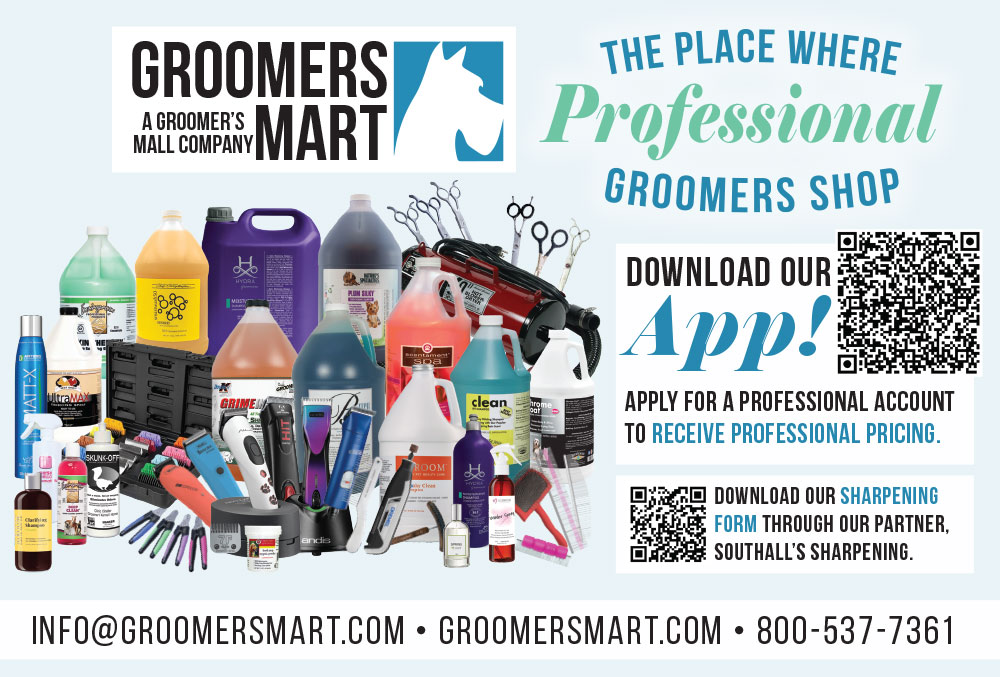
 lippers and shears are important for achieving the desired style, but what about tools and equipment for addressing the behavioral side of dog grooming? Experienced groomers, confident in their ability, often choose the right tool for every step of executing the perfect groom; however, it’s also crucial to know which tools to use for training support.
lippers and shears are important for achieving the desired style, but what about tools and equipment for addressing the behavioral side of dog grooming? Experienced groomers, confident in their ability, often choose the right tool for every step of executing the perfect groom; however, it’s also crucial to know which tools to use for training support.
Tools and equipment used to aid in behavior are not always straightforward. While there are a few that are commonly used, others might be more surprising. For example, when working with a dog that exhibits problematic behaviors during grooming, a well-fitted basket muzzle might be conditioned as a part of the training plan. But other items such as reward pouches and even target sticks that are commonly used in animal husbandry training are becoming more frequently seen in training dogs for grooming, too.
Training dogs for grooming involves motivating owners to work with their dogs at home. However, most pet owners lack professional tools and should not attempt certain techniques. An excellent skill asset for dog trainers is the ability to come up with easy-to-find items and teach pet owners how to use them to improve their dog’s behavior during grooming.

Loaded with a lickable dog snack, the mat makes pairing bath time with something the dog enjoys (food) simple. While every case is different, this tool might be helpful for trainers to suggest when providing homework specific to training dogs for the bath. The method and plan for implementing the enrichment mat, such as whether it will be phased out, all depends on the individual dog’s case.


Trainers offering group classes should consider investing in a grooming dryer to be used during classes. A networking idea for groomers is to reach out to trainers in the area who don’t have grooming services available at their location. They can discuss the advantages of having a grooming dryer for training purposes and offer a complimentary demonstration of the drying process to their students. The groomer can do this in exchange for leaving cards for the puppy students. This could be a great way to connect with new puppy owners looking for a groomer.

Many dogs react to the sound of the nail trim. With each clip, their anxiety seems to build. Using ear protection to muffle the sound, many dogs will immediately react less to the nail-trimming process. Pet owners at home may hesitate to trim their dog’s nails. However, they can introduce more helpful paw-handling by touching each nail while exposing the dog to the sight and sound. A wooden skewer works well for this. You can clip the skewer with nail clippers, which will sound just like a nail being clipped. Use inexpensive nail trimmers or ones that are already dull to save good nail trimmers from becoming dull.
Another sound of nail care involves the nail grinder. While nail-grinding solves the problem of sharp nails, not all dogs are cooperative during the process. To practice at home, owners can use an electric toothbrush. The toothbrush sounds like the nail grinder and it helps acclimate dogs to the feeling of one as well. It is a useful tool for trainers in puppy classes, showcasing successful nail-care preparation for puppies.

One tool trainers can use to help teach dogs how to behave for being brushed, which they can teach to owners, is a brush with the pad of pins removed. This is an easy way to teach dogs to settle for brushing and teach puppies that the brush is not a toy. The key is for the owner to practice brushing without using a brush on the coat.
Dogs and puppies should learn to be brushed without inspecting the brush. Many owners feel the need to show their dog every tool. This can become problematic if the dog continues to sniff and follow the tool. Presenting a brush to a puppy is too similar to presenting a toy. It is more helpful for the puppy to learn to look forward instead of following the movement of the brush.
Not all grooming training tools need to be obvious. To find the best tool, it’s helpful to think about the end goal and take into consideration the behavior of the dog. This will tell you at what level the dog needs to be introduced to the aspect of grooming that is being addressed. Helping owners train their dogs for the grooming salon can be a challenge but is well worth the reward.

